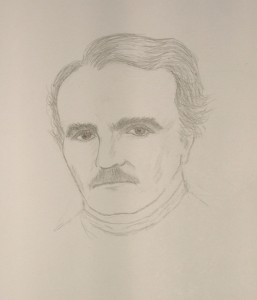As well as learned technique I should add.  And I’m finding out that what I’d learned in courses on literature and writing need be applied in art as well.
And I’m finding out that what I’d learned in courses on literature and writing need be applied in art as well.
As you can see, my version of Edgar is coming out looking more like a friendly Scotsman, perhaps a carpenter or woodsman of some sort. I have several images (all that are available I think) of Poe, and I’m trying to use just the photographs rather than the renderings. A note on the photos–because of the photographic techniques of the era almost all of the images have a mirror image, and with Poe, his most telling feature is his hairline. Now we all know that whatever way Mom parted sonny’s hair, it stays that way for the rest of the man’s life (unless he went through the 60s and 70s and went from hippie ponytail to afro). We also know that faces are not exactly the same on the left side as the right. I noticed this once when I saw my dad’s face in a mirror. We get used to the image we see–larger left eye, drooping right corner of the mouth, etc. So which are the true photos of Poe?
I’ll have to keep working on this obviously, but one thing has come clear: there are details to look for and emphasize in art just as in reading and writing. There’s a good, better, best way of doing everything. In art, I’ve rarely drawn from life or from photos; though I’ve mainly done faces and bodies, it’s been from imagination. I’ve also sought realism. Just as in writing experimentation that releases the true creative spirit, caricature would be the most useful exercise in learning to find and capture those features of a face that make someone recognizable even in a dozen pencil strokes. Conciseness is the writing equivalent of caricature in art.
I may be looking for some art courses come Spring.

 The Lost Children: A Charity Anthology
The Lost Children: A Charity Anthology